Fw: 37:01.50N 07:57.0W The Algarve

Toucan
Conor & Marion Wall
Fri 15 Oct 2010 21:12
|
Sines to Faro
We left Sines on the 6th October to rendez-vous
with our friends Malcolm and Angela, Angela's sister Valerie and
husband Malc at Lagos. For once we were one of the first boats to leave the
marina, leaving at first light for the 75 mile sail to Lagos. The morning
was calm so we motored for about an hour or so until the wind picked up to
approximately 8 knots from a SW'ly direction. This turned out to be just perfect
as our boat will not sail very well in 8 knots of wind when running but on
the beat in 8 knots of wind she moves along nicely at a speed of about 5 knots
through the water. On occasions throughout the day we had to revert to the motor
to keep up a reasonable average speed and as the day progressed a couple of
boats that left after us but under motor, overtook us and vanished out of
sight. We had one other boat that was further out to sea keeping pace with us
and this was nice. Last time we did this stretch of water we were also blessed
with good weather but we have heard stories of boats rounding Cape St Vincent in
horrendous conditions.
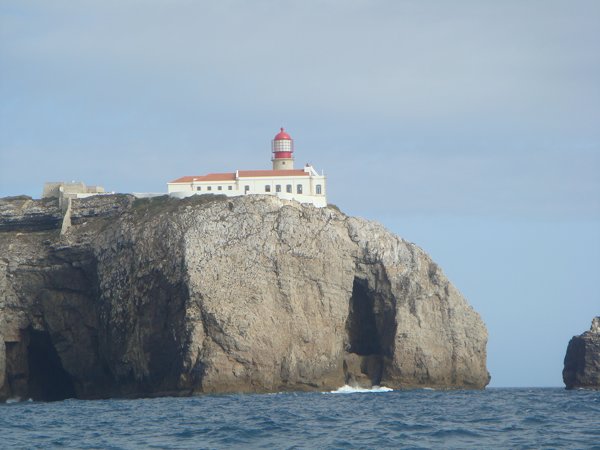 Cape St Vincent at the SW corner of
Portugal.
Following a rather uneventful day sailing, apart
from the usual dolphins and lobster pots, we arrived at the Cape St
Vincent at 1700 hours only a few boat lengths in front of the other boat
that was shadowing us most of the day. She was a ketch rigged steel boat
slightly larger than us and flying the American flag. Almost as soon
as we rounded Cape St Vincent the sea temperature gauge rose by over 2
degrees. this meant that for the first time since leaving Christchurch, swimming
was going to be a pleasant experience. As our passage had been relatively slow
since leaving Sines, it would almost certainly be dark before we would arrive in
Lagos. For this reason we decided to anchor in the bay of Sagres for the night.
Exactly a year earlier we had spent a lovely
holiday with Marion's sister and partner in a delightful house that
overlooked this bay and here we were, this time in our boat looking to the land
and the house we had stayed in. It did seem a little deja-vu moment. The Sagres
bay is reasonably sheltered especially in the predominantly Northerlies but on
this occasion with the SW'ly wind, although light, we had a slight swell running
into the bay. However this did not create a problem. We did not row ashore in
the dinghy as we felt that we knew this place well enough from our
previous holiday there. However a lovely and long swim was enjoyed by both of
us and seemed the perfect way to finish a pleasant
days sail.
By the morning the wind had turned northerly and
was strengthening. We left Sagres mid morning for the relatively short sail to
Lagos and as we sailed along the coast we were almost knocked flat by a sudden
gust of wind off the land. This happened quite a lot along this whole stretch of
coastline. The first one caught us by surprise but a quick release of the
mainsheet was enough to control the boat and a very quick passage was made with
some nice high speeds showing on the gauge from time to time. Along this stretch
of coastline we spotted shark on more than one occasion and these were not
basking shark as we have seen plenty of them off Cornwall and know what they
look like. So it is anyone's guess as to what they were but they were certainly
large.
At Lagos we tied up to the waiting pontoon of the
Lagos Marina and checked in with reception. The World Cruising organisation
had negotiated a deal with this marina so the first night would be free and
thereafter a discount of 10% for ARC participants. It is always a nice feeling
when you get something for nothing.
That evening our friends arrived and a pleasant
time was had catching up with news and gossip not to mention
a little lubrication of the throat. We dined ashore in a
little restaurant that is not so well known to the tourists but where value
and quality was fantastic. It did mean a 20 minute wait in the street until a
table was free but that is part of the ambiance of eating out in Lagos. Lagos is
a bustling and very attractive town and very popular with the British and
Irish as well as others so a lot of English is spoken and heard in the streets.
A complete contrast to what we were used to in the rest of Portugal and Spain on
our travels down the coast. As our first port of call ashore in the
Algarve we expected that this would be the norm. for the rest of the
Algarve yet to be visited.
The following day our friends were back again for a
day of fun on 'Toucan'. They are not experienced sailors so we just did a little
trip out to the cliffs beyond the marina where there are many unusual and
exciting cliff formations to be seen. The caves were full of sightseeing boats
from Lagos, some were very strange in shape and all jostling for
position but we just kept our distance off and watched the spectacle of
small boats weaving in and out between the rocks and caves in these
cliffs.
 Just one of the many weird craft full of
holiday makers, all down below looking out through the glass
bottom
We then anchored in the bay and had the obligatory
swim before passing the afternoon away. Whilst in Lagos, Marion took
advantage of the hired car that my friends had and went to the
supermarket to stock up on the heavy items such as longlife milk, bottled
water, beer and wine etc. She even managed to find three handsome men, well
one anyway, to transport the food from the car to the boat. Notice how the
handsome one even managed to get out of pushing the trolley.
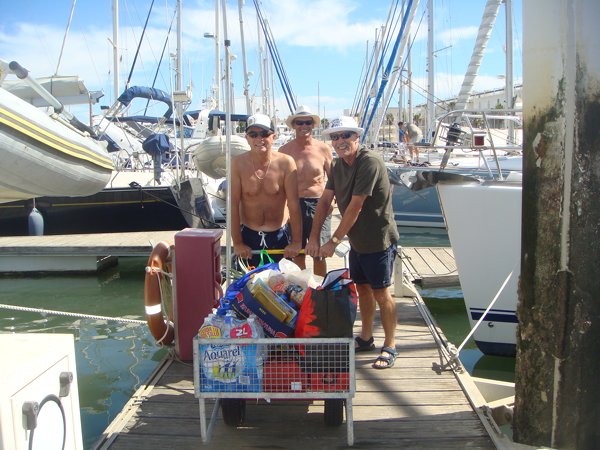 Delivery Boys
The following day we were a little more adventurous
with our friends and had a little sail to the next harbour East of Lagos
called Alvor. The entrance to Alvor and the harbour once inside is not
unlike Christchurch harbour. There is a bar, there is a run and inside is
similar in regard to the shallow harbour with large drying areas and some very
small islands.The town of Alvor is quaint with small streets, lots of bars and
restaurants and full of life. Having negotiated the run with an ebbing tide of
at least 5 knots that caused some large waves at the bar we dropped the anchor
off the small Island that could have been Blackberry Island in Christchurch
harbour. However this island was being used to treat the tourists to a 'South
Pacific Island Experience' complete with parasols and loungers.
 Notice the diminishing island as the tide
rises, Alvor in the background.
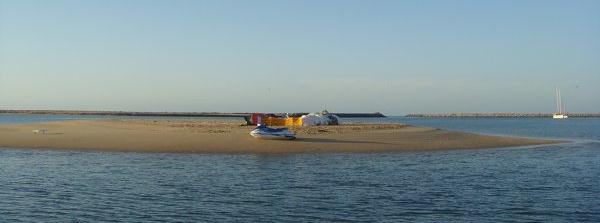 This is what it looked like the following
morning as we passed.
Another day was spent with our friends at their
apartment on the very exclusive Golf Course on the outskirts of Lagos and
another on the beach in Portimao which was our next port of call after
Alvor.
From Portimao I took a train to Faro to see at
first hand the yard that was going to 'park' our temporary home out of the
water whilst Marion and I returned to Christchurch and Dublin. We
would be away from the boat for just over three weeks. I was happy with
what I saw at the yard and the arrangement was made. Toucan was to come out of
the water after nearly two and a half years of being afloat.
I had planned to crane out in Christchurch in June
just before we started our journey and the arrangement was made with Elkins boat
yard. On the previous occasion that I was craned out at Elkins they had a
rather old crane which a lot of you will remember. At the time Matthew
(Elkins) was worried that the old crane might not lift our new boat so
I emptied her of all the heavy gear before taking her down. The old crane had no
trouble lifting her. However on this occasion Matthew was certain that the new
crane would manage without and need for me to lighten her so I didn't take any
of the gear off. They failed and that left me in a bit of a difficult position
as I now only had a matter of weeks to arrange a lift out somewhere else to do
the antifouling and change some anodes. To cut a long story short I decided to
take her to Studland and beach her to see how dirty she was under the water. It
turned out that we had very little growth even after two years so I decide to
just clean her off and change the propeller anode, which was showing some signs
of wear, on the low tide. This all worked out rather better than expected
and with the help of my son Christopher the job was done and a pleasant days
sailing enjoyed in the process.
So here we are with just a few days to craning
out and only one port between us and Faro, a place called Albufeira. Some
people call the marina Legoland because of the colours and shape of
buildings surrounding the marina.
I don't know why we decided to go there, but, there
we went. It not only was the most expensive marina so far but we were
unable to avail of their electric due to the fact that they put us on the
pontoon that the superyachts and tour boats used and the electric sockets
were so large that you could stick your finger into the holes (no. I didn't). I
do carry large plugs for large sockets but these were XXL. I also got told-off
for using one of the water hoses that apparently belonged to a Tour operator.
The Marina is quite a long way outside the town of Albufeira and as it was
fairly late in the evening we did not fancy the hike. When I asked the following
morning about the lack of facilities they excused themselves by telling me that
the harbour normally only takes visiting boats up to 12 meters and gave me
a 10% discount. How generous of them.
We left Albufeira for our final sail along the
coast on Tuesday 14th September, the same day that my friends returned to
Bournemouth airport. I think we saw their plane go over our heads as we sailed
out of Albufeira. We arrived at the entrance to Faro in the company
of an Ovni 365 'Alibi' owned by Henry & Linda
Freeman. We first met Henry in La Roche Bernard in the Vilaine River,
Brittany in 2000 (or was it 2003) when we were sailing Brittany in Idle
Spirit our previous Ovni 36. Henry and a friend asked if they could come on
board to have a look at our boat and of course we had no problem with that. He
was obviously sold on the idea of owning his own and now here we were sailing
side by side, in similar boats.
The entrance to Faro also has a bar to cross and
again a very strong tidal flow. Once again we had the ebbing tide as we entered
and at least 5 knots of current against us but once inside we had a huge area
and tons of choices of places to anchor. The area of water once inside the
entrance is huge. Think of Chichester harbour and treble it. One side of the
entrance to this large expanse of water is and island called Ilea ad Clara and
it really is no more than a mass of sand a little over four miles long and
approximately half a mile wide but on here lives a community of people
engaged mostly in fishing with two schools, one Church, a couple of shops and
many more restaurants and bars.
Not the sort of island I would wish to
live on. The football field was sand and there appeared to be no grass at all
anywhere apart from the sea grass that grows wild on sand dunes. No cars or
roads but lots of paths wide enough to take a small tractor
although there were precious few of them to be seen.
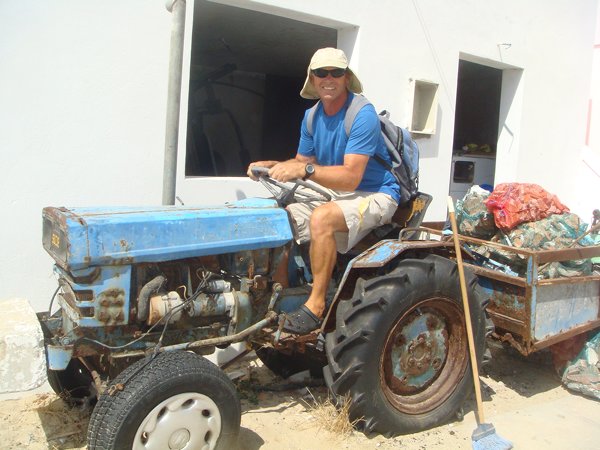 This looks in reasonable condition but it
is very badly rusted and you may have noticed that I am not sitting down. Tyres
look nice though.
The beach and small harbour on the inside of the
island were full of small open fishing boats of all shapes and sizes and as
Marion and I ate our Seafood Cataplana in one of the restaurants
overlooking the harbour and beach we noticed a steady stream of
mostly women heading off to repair nets, each with their own repair kits in
little boxes and satchels. It was like something out of a different age.
Obviously these folk being somewhat cut off from the mainland are in some kind
of time warp and it was lovely to see.
We spent a couple of nights on anchor
here before heading up to the pre arranged spot to await the tide to get up
to the boat yard for the hoisting out process. The boat yard is at the very
head of the estuary to Faro and almost directly under the flightpath to the
airport. We were to go to buoy 23 and anchor and wait for the tender from the
yard to escort us in through the shallows. We arrived at buoy 23 but there was
not a lot of room to anchor. Luckily the wind was light and we finally found a
spot that more or less blocked the channel. Buoy 23
is directly under the flight path and we were soon to
discover just how close the planes coming into Faro were to get to the top of
our mast.
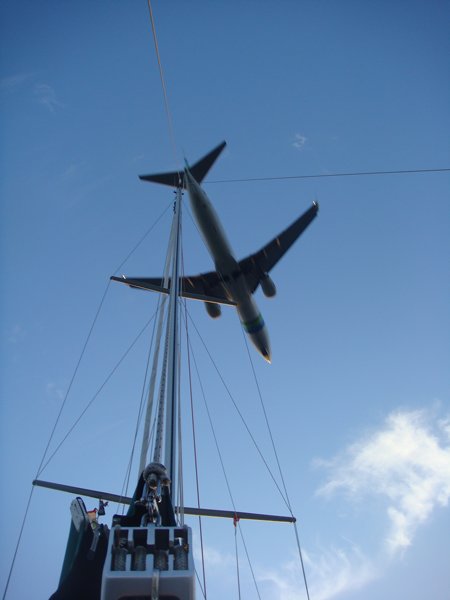 Yes that's our mast.
The next amazing thing that happened almost exactly
30 seconds after the plane crossed over us was that there was a sudden wave of
wind that you could clearly hear but not feel. It was ghostly like and if that
had happened without the plane having gone over I would have been out of there
like grease lighting. However after it happened a few times it was quite a weird
feeling as the wave of wind seemed to ruffle the marshes although we could not
see anything moving. To make matters worse there was not a breath of wind before
or after the wave from the aircraft. I tried to capture the sound on my
phone recorder but had no luck.
We spent the night here to be ready for the
boatyard tender to come the following morning and had a peaceful night
as no planes landed after a reasonable hour but we were shook out of our
bunks just before 0700 the following morning. At 0900 we were on our way up the
tidal stream and were hoisted out immediately. It took a little longer to jet
wash the bottom of Toucan even though there was little growth of weed,
we still seemed to have collected rather a large number of tiny barnacles.
By the time the jet washing was over you could have paved a small drive with
what came off even though there was not a single barnacle on her in
Studland. Toucan was ready for her slot in the yard by lunchtime and I
started work preparing for antifouling, changing the necessary anodes and
greasing the MaxProp propeller. By Friday evening all was completed and she
looked the part again and now ready for the big one out into the Atlantic on our
return.
A final note about mainland Portugal before
we move out to the islands.
I mentioned in one of my blogs how we saw so many
houses in most of the towns and villages that were in a terrible state of repair
even though a lot of these houses were one time fine buildings. Well below
is the reply my brother got from a colleague of his, a scrutiny officer in the
Portuguese Ministry. "All over the country you find that kind of situations. Usually, the
owners don’t have money to repair their houses. And even if it is a rented
house, the owners still don’t have money and the rents are too low to get a
profit from it. Nowadays, we have legal diplomas that state that there should be
an annual update of the amount of the rent (the same as the inflation). Before
we had those diplomas, the amount of the rent was untouchable. If you, landlord,
had rented a house in 1950 for 5 euros… it would now still be 5 euros! For that
money, you couldn’t possibly repair the house. When the tenant dies, then those
houses are sold very cheap and the new owners can repair them."
|